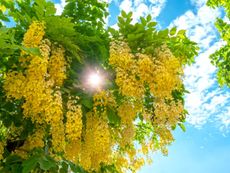Growing Cassia Trees - Tips For Planting A Cassia Tree And Its Care


No one can visit a tropical locale without noticing the multi-trunked trees with golden flowers cascading from the branches. Growing cassia trees (Cassia fistula) line the boulevards of many tropical cities; and when you see one in full flower for the first time, you have to ask, “How hardy is a cassia tree and can I take one home?”
Cassia Tree Info
If you live anywhere north of growing zone 10b and don't have a climate controlled greenhouse, the answer is probably no. If you do meet one of those requirements, you're in luck. Cassia tree info tells us that, depending on the species, these trees come in evergreen, semi-evergreen, and deciduous types with brilliant pink, orange, red, white, or yellow flowers. Yellow is the most common flower type and gives the tree one of its many common names, the gold medallion tree. Each flower is only about 2 to 3 inches (5-8 cm.) wide but appear in clusters along densely packed racemes that on a mature growing cassia tree can reach 2 feet (61 cm.) long. The light green leaves of the cassia tree are pinnate with six to twelve pairs of long oval leaflets and grow to 2 feet (61 cm.) or more. Once flowering is over, the flowers are replaced with seed pods.
Growing Cassia Trees
If you live in an area that meets the requirements of how hardy is a cassia tree, planting a cassia tree can be a striking addition to your landscape. Most cassia tree info recommends growing cassia trees from seed. There's a trick to this, however. The seeds are rock hard and water tight, so you can either soak them in sulfuric acid (No kidding! And it needs to be concentrated, too. In nature, this process occurs in the digestive tracts of animals), or you can scarify or slit the seed coat. Soak the seed in water for at least 24 hours and nick the seed with a sharp knife. Keep the seed moist in a pot of commercial growing medium. You can, of course, purchase a tree from your local nursery or order it from a catalog. The following directions for planting a cassia tree will be the same.
Tips for Planting a Cassia Tree and Its Care
Cassia tree care requires very little, but that little is important. Once your seed has germinated and has about six leaves, it's time to decide where your tree will be growing. Cassia trees need full sun to flower and produce the most colorful blossoms. They are tolerant of most soil types with a neutral pH, and while they like water, they do best in well-drained soils. Dig your hole twice the size of the root ball and add peat moss and compost to the fill dirt, adding a handful of slow release fertilizer. Planting a cassia tree this way will give it the healthiest start. Leave a trough around your tree to collect water and see that it is watered regularly until the roots are well established. Young trees need to be staked and will look a little scrawny for the first five years or so and then it will begin to fill out. These trees have a tendency to ‘weep' so if you want a fuller look, pruning will be a part of your early cassia tree care. Still asking how hardy is a cassia tree? They rarely survive temperatures below 30 degrees F. (-1 C.) and since they reach heights of 20 to 30 feet (5-10 m.), that greenhouse better be a big one. Sometimes it's better to dream. For those of you who live in or on the edge of the tropics, think about planting a cassia tree as a lush, tropical canopy for your yard. One final word of warning. While all parts of the cassia tree were once used for ancient medical remedies, it is not safe to ingest any part of the tree. The seeds can be particularly toxic, so keep this in mind around children or pets.
Gardening tips, videos, info and more delivered right to your inbox!
Sign up for the Gardening Know How newsletter today and receive a free download of our most popular eBook "How to Grow Delicious Tomatoes."

Jackie Rhoades began writing for Gardening Know How in 2010.
-
 Grow a Bathroom Oasis: 8 Best Bathroom Plants With No Light or Low Light
Grow a Bathroom Oasis: 8 Best Bathroom Plants With No Light or Low LightSome apartment dwellers grow the best bathroom plants with no light or low light. Read how one of our favorite plant lovers does it in the big city.
By Teo Spengler
-
 "My Worst Mistake" – Gardeners Share 10 Hard-Learned Lessons
"My Worst Mistake" – Gardeners Share 10 Hard-Learned LessonsGardeners never stop learning, and sometimes our mistakes are the best teachers. But why not save time and heartache by learning from other gardeners' failures?
By Melanie Griffiths
-
 Cassia Tree Propagation: How To Propagate A Golden Shower Tree
Cassia Tree Propagation: How To Propagate A Golden Shower TreePropagating cassia golden shower trees is relatively simple if you follow a few basic rules. Click here for information about how to propagate a golden shower tree. We'll also tell you when to propagate a golden shower tree and other tips.
By Teo Spengler
-
 Cassia Tree Pruning: How And When To Trim Cassia Trees
Cassia Tree Pruning: How And When To Trim Cassia TreesPruning cassia trees helps strengthen their structure and keeps them looking neat. Learn more about pruning these trees in the following article. Click here to get additional information.
By Jackie Carroll